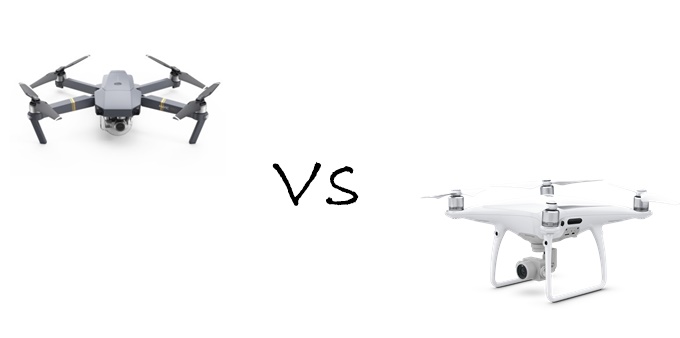1-12-2017 - DRONES: DJI MAVIC PRO v DJI PHANTOM 4 PRO/ADVANCED

When it comes to choosing a drone that’s right for you, there are many different factors to consider - the most important of which being the specific model of the drone. We’ve decided to compare two of the most popular models on the market - the DJI Phantom 4 Pro (and Advanced) and the DJI Mavic Pro - to help you make the best decision.
Whilst the original DJI Phantom 4 has been discontinued, the Phantom 4 Advanced and the Phantom 4 Pro are the current models available in-store. Except for the Mavic Pro Platinum (more about that in a future blog), the DJI Mavic Pro remains the only drone in its product line, but you should consider the characteristics of each model – and weigh those up against your requirements - before making a purchase.
Flight time
The published maximum flight time for the DJI Phantom 4 Pro/Advanced is 30 minutes, whilst the DJI Mavic Pro can fly for 27 minutes per battery. However, it’s worth noting that this is dependent both on environmental conditions and your flight profile. Maximum flight time is a factor to consider when deciding on the model you’ll purchase, but with only three minutes difference between these models, there are other factors that are more important.
Wind testing
The DJI Mavic Pro is much smaller and lighter than the DJI Phantom 4 Pro/Advanced, but this doesn’t make a notable difference when it comes to wind resistance. Both models perform similarly in windy situations, but the DJI Phantom 4 Pro/Advanced have larger motors which are advantageous when it comes to flying in turbulent conditions.
Comparison of specifications:
|
MAVIC PRO |
PHANTOM 4 (PRO/ADVANCED) |
|---|---|
|
|
|
Video specs:
|
Video specs:
|
|
Photo specs:
|
Photo specs:
|
Autonomous flight modes
The Phantom 4 Pro/Advanced and Mavic come with a multitude of autonomous flight modes, including active track, terrain follow, tripod, gesture and tap fly. These modes make it easier to record specific subjects without the need for constant control inputs.
Camera performance
When compared, there’s a big difference between the two cameras. The Phantom 4 Pro/Advanced have a larger image sensor, higher maximum video bitrate, full aperture control, faster image processor and a mechanical shutter. The Mavic Pro has a novel camera and gimbal design that is significantly smaller than the Phantom 4 Pro/Advanced. Despite its small size, the Mavic Pro’s camera is still capable of shooting photos with 12MP resolution, and video in 4K. The Mavic Pro’s camera can also rotate 90 degrees to shoot in portrait mode.
- Low light performance
The DJI Mavic Pro is not the best performer in low-light conditions. In these situations, the DJI Phantom 4 Pro is the better option. You also get a wider ISO range, and the ability to shoot in H.265.
- Focusing
Unlike the original DJI Phantom 4, the Mavic Pro and Phantom 4 Pro/Advanced cameras don’t have a fixed focus lens, meaning that you’ll have to tap part of the image that you want to focus on using the DJI Go4 app. Focusing can make the subject a lot sharper and the background will look slightly more out of focus like a DSLR. However, if you forget to do this, your images will be blurry.
Controller features
The DJI Mavic Pro controller is smaller but has the same basic buttons as the DJI Phantom 4 Pro/Advanced, with the addition of a stop button for the intelligent flight modes. The main advantage that the DJI Phantom 4 Pro/Advanced have is that you can buy the ‘Plus’ versions, which come with a built-in display. This display is about as twice as bright as a phone or tablet and – since it’s integrated into the remote control, requires no cables to charge or use it. The display also has a focus button integrated into the shutter button, and HDMI out port and an SD card slot. However, it’s worth noting that you can’t currently use it with third party apps, such as Litchi or Dronedeploy.
The DJI Mavic Pro controller has an LCD screen for basic flight info and charges through the micro USB port. Phones fit easily into the lower arms, and aftermarket tablet mounts are available for those who prefer larger screens.
Obstacle avoidance
The DJI Phantom 4 and DJI Mavic Pro both have obstacle avoidance functionality. They detect obstacles before landing and can take pictures of the ground before flight, enabling them to land in the same place from where they took off. The DJI Phantom 4 Pro has cameras in the back and infrared sensors on the sides for 360-degree obstacle avoidance. It can also travel faster than the DJI Mavic Pro and DJI Phantom 4 Advanced when obstacle avoidance is switched on.
Availability and price of accessories
A wide range of accessories are available for the Phantom 4 Pro/Advanced and Mavic Pro, from DJI, Freewell Industries and PolarPro. Accessories (including batteries) tend to be more expensive than those for the Mavic Pro, but not prohibitively-so. Popular accessories include gimbal locks and ND/Polariser filters.
So, which drone should you choose?
It really depends on what you intend to use your drone for. For photography enthusiasts or professional photographers/cinematographers, the DJI Phantom 4 Pro or Advanced are better since they have superior camera quality. The additional obstacle-avoidance sensors on the Pro/Pro+ are also great for proximity flying. The Mavic Pro is super-compact and has a decent camera, and a fantastic live video feed. The bottom line is that if you choose the model that meets your requirements, either the Mavic Pro or Phantom 4 Pro/Advanced are outstanding drones – you can’t really go wrong. With specials on offer for all three models through the end of 2017, now is the time to buy!
